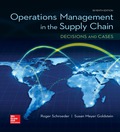
a)
To classify: The type of process.
a)
Explanation of Solution
Given information:
The process is “Doctor’s office”.
Classification:
The process is classified as a job shop or project. The patients will require different services for each of them. The services offered will be customized in nature. Hence, it is a job shop or project.
b)
To classify: The type of process.
b)
Explanation of Solution
Given information:
The process is “Automatic car wash”.
classification:
The process is classified into an assembly line flow. The car wash is a linear sequence of operations that are performed in a sequential manner.
c)
To classify: The type of process.
c)
Explanation of Solution
Given information:
The process is “College curriculum”.
classification:
The process can be classified into any of the processes of continuous, batch, job shop, project or an assembly line. It can be termed as an assembly line, if the similar course is needed by all learners. It can be termed as a batch process, if the curriculum is suited for a particular degree. It can be termed as a project, if the course is custom-made to single learner.
d)
To classify: The type of process.
d)
Explanation of Solution
Given information:
The process is “Studying for an exam”.
classification:
The process is classified as a project. It is distinctive for each learner for different exams.
e)
To classify: The type of process.
e)
Explanation of Solution
Given information:
The process is “Registration for classes”.
classification:
The process is classified as an assembly line. The students will be required to perform the same sequence of steps with only a minimum amount of variation.
f)
To classify: The type of process.
f)
Explanation of Solution
Given information:
The process is “Electric utility”.
classification:
The process is classified as a nonstop method as it is specifically standardized one. It can be programmed to a big degree to attain a low unit cost.
Want to see more full solutions like this?
Chapter 4 Solutions
OPERATIONS MANAGEMENT IN THE SUPPLY CHAIN: DECISIONS & CASES (Mcgraw-hill Series Operations and Decision Sciences)
- Define risk management and explain its importance in a small business.arrow_forward1. Define risk management and explain its importance in a small business. 2. Describe three types of risks commonly faced by entrepreneurs. 3. Explain the purpose of a risk register. 4. List and briefly describe four risk response strategies. (5 marks) (6 marks) (4 marks) (8 marks) 5. Explain how social media can pose a risk to small businesses. (5 marks) 6. Identify and describe any four hazard-based risks. (8 marks) 7. Mention four early warning indicators that a business may be at risk. (4 marks)arrow_forwardState whether each of the following statements is TRUE or FALSE. 1. Risk management involves identifying, analysing, and mitigating risks. 2. Hazard risks include interest rate fluctuations. 3. Entrepreneurs should avoid all forms of risks. 4. SWOT analysis is a tool for risk identification. 5. Scenario building helps visualise risk responses. 6. Risk appetite defines how much risk an organisation is willing to accept. 7. Diversification is a risk reduction strategy. 8. A risk management framework must align with business goals. 9. Political risk is only relevant in unstable countries. 10. All risks can be eliminated through insurance.arrow_forward
- 9. A hazard-based risk includes A. Political instability B. Ergonomic issues C. Market demand D. Taxation changesarrow_forward8. Early warning indicators help businesses to A. Avoid legal actions B. Grow rapidly C. Detect potential risks D. Hire employees 9. A hazard-based risk includes A. Political instability B. Ergonomic issues C. Market demand D. Taxation changesarrow_forward10. Which risk category refers to taking advantage of a new opportunity despite potential challenges? A. Hazard B. Uncertainty C. Opportunity D. Strategicarrow_forward
- 6. A business continuity plan is mainly used to_ A. Increase profits B. Handle daily tasks C. Prepare for disruptions D. Advertise services 7. What is the role of a risk owner? A. To finance the risk B. To monitor and manage a specific risk C. To create risks D. To avoid planning 8. Early warning indicators help businesses to_ A. Avoid legal actions B. Grow rapidly C. Detect potential risks D. Hire employees 9. A hazard-based risk includes_ A. Political instability B. Ergonomic issues C. Market demand D. Taxation changesarrow_forwardFill in the table below with the activity times after crashing to show the resulting schedule. (Enter your responses as whole numbers.) Activity A B с Time according to schedule (weeks) Activity F G H Time according to schedule (weeks) D E COEarrow_forwardGiven the information below, estimate the probability that the noncritical path B-F-G will take more than 20 weeks. Hint: Subtract from 1.0 the probability that B-F-G will take 20 weeks or less. Refer to the standard normal table. Activity A Expected Time (weeks) Variance 3.5 1.00 BCDE 5.5 0.96 C 4.0 0.45 12.0 1.78 6.5 2.25 F G 9.0 2.78 4.5 0.69 The probability that this path will take more than 20 weeks to complete is (Enter your response rounded to four decimal places.)arrow_forward
 Purchasing and Supply Chain ManagementOperations ManagementISBN:9781285869681Author:Robert M. Monczka, Robert B. Handfield, Larry C. Giunipero, James L. PattersonPublisher:Cengage LearningMarketingMarketingISBN:9780357033791Author:Pride, William MPublisher:South Western Educational Publishing
Purchasing and Supply Chain ManagementOperations ManagementISBN:9781285869681Author:Robert M. Monczka, Robert B. Handfield, Larry C. Giunipero, James L. PattersonPublisher:Cengage LearningMarketingMarketingISBN:9780357033791Author:Pride, William MPublisher:South Western Educational Publishing Contemporary MarketingMarketingISBN:9780357033777Author:Louis E. Boone, David L. KurtzPublisher:Cengage Learning
Contemporary MarketingMarketingISBN:9780357033777Author:Louis E. Boone, David L. KurtzPublisher:Cengage Learning


